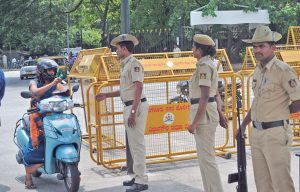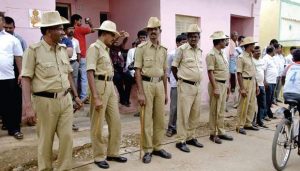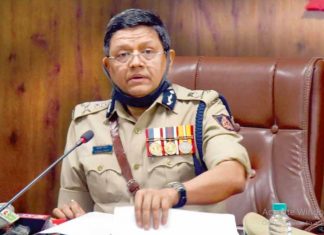Community policing is a practice prevalent in India for ages wherein the people from the neighborhood participate in the system as moral police and keep a watch around their locality with an intention to maintain peace and tranquility. As a modern system, policing has community involvement in its functioning as a mandate now, the primary aim being:
(a) To help police reach places and problems where they have limited access and are omnipresent with civilians as their eyes and ears.
(b) To bridge the gap that has long been created between the police and people due to errant ways of police working and reduce the fear that is instilled in the minds of common people.
There are many states that have community policing as a practice running successfully. Although fervent attempts have been made in the state of Karnataka to run this practice successfully as an obligatory system, the one initiated by Janaagraha, an NGO situated in Bangalore has been basking in the limelight since its initiation in June 2013. The attempt has earned popularity and common support as it has been started in one police station in each of the seven zones of the Bangalore city. The present paper is a review on the emergence of the practice of community policing in Karnataka state and its modernization with the advent of Janaagraha as a primemediator between the police and the public in recent times.
The article is purely based on secondary review and information from newspapers and journals on the subject.
Introduction
 Community policing is the collaboration between the police and the community that identifies and solves community problems. In community policing, the police are not the only sole guardians of law and order. All members of the community become active allies in an effort to enhance safety and security of the neighborhoods. The expanded outlook on crime control and prevention, the emphasis on making community members active participants in the process of problem solving and the patrol officers’ pivotal role in community policing require profound changes within the police organization. The neighbourhood patrol officers, backed by the police organization, helps community members mobilize support and resources to solve problems and enhance their quality of life. Community members voice their concerns, contribute advice, and take action to address these concerns. Creating a constructive partnership will require the energy, creativity, understanding, and patience of all involved.
Community policing is the collaboration between the police and the community that identifies and solves community problems. In community policing, the police are not the only sole guardians of law and order. All members of the community become active allies in an effort to enhance safety and security of the neighborhoods. The expanded outlook on crime control and prevention, the emphasis on making community members active participants in the process of problem solving and the patrol officers’ pivotal role in community policing require profound changes within the police organization. The neighbourhood patrol officers, backed by the police organization, helps community members mobilize support and resources to solve problems and enhance their quality of life. Community members voice their concerns, contribute advice, and take action to address these concerns. Creating a constructive partnership will require the energy, creativity, understanding, and patience of all involved.
What is Community Policing?
The concept of community policing is relatively new to the commonwealth countries. Due to their colonial past, people never perceived the police as a friendly force. Instead, the mutual trust quotient has always been low as policemen in these countries were seen not as protectors but as tools of a foreign power to keep people under control and in awe of their colonial masters. Thus, historically speaking people have always feared the police,and this fear, this gap, this widening mistrust between the police and the public has remained intact till date to a considerable degree.
Global Perspective
The success of community policing largely depends on the faith that a community bestows on its policing system and the attitudes the citizens carry about the police. There has been very limited work done on the subject. One such study has been done by Holmes. M.D. It focuses on the theoretical and analytical effects on community in context of police organization and individual opinions & attitudes about police. The study carried out in the small town of Iowa, at a community level observed that social disorganization was negatively associated and social integration was positively related to trust in the police. And in totality, contextual, organizational and individual predictors all had important effects on attitudes about police in this study.
A work by Blaustein. J, analyzes the implementation of a Swiss community policing model in Sarajevo Canton, Bosnia-Herzegovina. The study depicts how officers from one community policing unit were able to facilitate cultural legitimation for their community policing role within their sector by linking it to established, subcultural definitions of police work. Another article by Topping. J provides a structural and operational analysis of policing beyond the police in Northern Ireland. Thus, this paper provides an empirical assessment of the complex, non-state policing landscape beyond the formal state apparatus. It examines definitions and structures of such community-based policing activities.
Forensic Research
An open access journal explores issues related to co-opting this non-state security ‘otherness’ into more formal relations with the state. Through a global perspective there have been a lot of experiments done to monitor the success of community policing in various parts of the world. The above reviews are a mere reference of three such examples of various attempts made to curb the lacunae existent in police-public relationship. The present paper highlights such community policing practices tried in Karnataka state on the basis of different models and a detailed account on the most successful model implemented by the Janaagraha.
Community Policing in Karnataka
Community policing system being mandatory has been initiated in many parts of Karnataka state. Some of these initiations have had mammoth positive outcomes and have attained remarkable success due to excellent police public cooperation. In Chikmagalur district a 15-member community interface team was formed in Sringeri in October 2005, in addition to the community interface teams consisting of two police personnel from all police stations in Koppa and Chikmagalur subdivisions. This has been a huge booster in setting right several personal and community problems in the naxal affected areas in these regions.
 In Mysore, a total of 400 men are roped in by the police to assist them in ending the menace of chain-snatching in the city. The men are called community police officers. The concept of community policing was thought of, owing to the increasing number of chain snatching incidents in the city. The police had invited applications from interested persons in this regard. One of the conditions imposed by the police for the applicants was that they should have a two wheeler and a mobile phone. A rigorous scrutiny was done to select thirty men in the limits around every police station for the project for a period of two months. These men were also given identity cards and their assignments were on priority during cultural programs. They also had the responsibility to prove the information related to investigation.
In Mysore, a total of 400 men are roped in by the police to assist them in ending the menace of chain-snatching in the city. The men are called community police officers. The concept of community policing was thought of, owing to the increasing number of chain snatching incidents in the city. The police had invited applications from interested persons in this regard. One of the conditions imposed by the police for the applicants was that they should have a two wheeler and a mobile phone. A rigorous scrutiny was done to select thirty men in the limits around every police station for the project for a period of two months. These men were also given identity cards and their assignments were on priority during cultural programs. They also had the responsibility to prove the information related to investigation.
Recently, in Bengaluru the police from some divisions have introduced one more new system called “SLUM DOMINATION”. This is a very unique and latest measure adopted by the police to reduce crime rate by visiting the slum areas regularly and maintaining the social accountability in the slum areas. Police meet people involved in criminal activities in the past, those on the Rowdy Sheet, young and first time offenders and keep a check on all their daily activities. If nothing wrong or suspicious is found then police assure them of removing them from the Rowdy Sheet and charges on them will be reduced. This is also a part of community policing where police is taking initiative to control crime and other illegal activities in the society. The most modern and recent attempt of community policing in Karnataka has been launched by Janaagraha, an NGO situated in Bangalore in affiliation with the police force. Jana Suraksha Samithis (JSS) were created earlier in 2013 as community meetings between Area Suraksha Mitra’s (ASM) and police officials actively involved in the Community Policing Programme. To begin with, it has been started in seven police stations limits, one in each zone. The Jana Suraksha Samithis (JSS) carry out the meeting between police & public and discuss the different safety issues. These meetings provide a touch-point for communication, relationship building and problem solving. The aim of the Community Policing Programs is to use participants from entire citizen population to improve the safety and security of the neighborhoods. Citizen volunteers, called Area Suraksha Mitra’s (ASM), work in partnership with police.
Awareness Programme by JSS
Several awareness programmes are being carried out by Jana Suraksha Samithis (JSS) meetings through various organizations like:
1) Karnataka State Commission for Protection of Child Rights (KSCPCR)
2) Karnataka State Commission for Women (KSCW)
3) Child Welfare Committee (CWC)
4) Center for Addiction Medicine (CAD).
The purpose of these awareness educative programmes is to sensitize Area Suraksha Mitra’s (ASM) and police personnel, sothat they can monitor their own activities in their field and raise awareness among the communities they represent.
Beat Level Awareness
To make the Community Policing Programmes a success, it is necessary that all Area Suraksha Mitra’s (ASM) and police personnel must meet citizens in their beats regularly. In order to do so, the Community Policing teams organize beat level awareness programmes, with participation of Area Suraksha Mitra’s (ASM) and police personnel.
Social Media Platform
 The police in Bengaluru has undertaken the initiative of making their presence felt in the social media platform and to engage with the whole community. With the help of the social media channels like Face Book, Twitter, You Tube and Blogs etc., the Bengaluru police desires to take existing relationship of police and community to the digital world. This will improve communication and build better police community relations. As it is, Bengaluru is the IT capital of the county and public has adopted social media channels to their convenience in larger numbers as compared to other cities. Thus, it is imperative that we make our presence felt in these community tools and make use of them to communicate with the people. This engagement has to be done on a real time and 24×7 basis, so that people get the information they want instantly. For this, a dedicated team is being setup and trained exclusively by Havas Worldwide.
The police in Bengaluru has undertaken the initiative of making their presence felt in the social media platform and to engage with the whole community. With the help of the social media channels like Face Book, Twitter, You Tube and Blogs etc., the Bengaluru police desires to take existing relationship of police and community to the digital world. This will improve communication and build better police community relations. As it is, Bengaluru is the IT capital of the county and public has adopted social media channels to their convenience in larger numbers as compared to other cities. Thus, it is imperative that we make our presence felt in these community tools and make use of them to communicate with the people. This engagement has to be done on a real time and 24×7 basis, so that people get the information they want instantly. For this, a dedicated team is being setup and trained exclusively by Havas Worldwide.
The objectives of the programme
- Building awareness of the citizens about the organization and work being done by police.
- A source for all the information, news, updatesregarding crime, criminals,law enforcement situation in the city.
- To use it as an extended PR tool by giving news, views and official statements via tweets, updates…etc to avoid rumours.
- For crisis management by providing citizens within formation, that they lookfor during the times of crisis.
- To build community policing using social media.
- Gather information from social media monitoring.
- With this initiative, the police will be able to engage, energize, analyze and interpret community needs in a much better way and deploy adequate resources to resolve these things properly.
- The police will also be able to judge the pulse of the people and know what is agitating them. This can also act as an early warning system for the police and they can then think of appropriate remedial measures.
The following are some of the ways in which a community member can involve himself and help the community:
- Neighborhood Watch Committee can be vigilante of each other’s houses during holiday, etc.
- In localities which are susceptible to dacoits, robberies, burglaries, members along with the beat constables can perform night beats.
- Inform police about any suspicious person in the locality spending lavishly without any authenticated livelihood to your jurisdictional police.
- Taking assistance of the unemployed youngsters, not letting them waste their time. Participate in Civilian Rifle Clubs and organize civilian rifle training in consultation and association with police.
- Help the elders if there is no one to look after them by giving service of being available for medicine, hospital, banks etc. and no stranger should get make them target.
Conclusion
Since community policing is a unique relationship between police and public, it finds its strength in mutual trust and sensitizes people to perform their role in solving their problems and enhance over all quality of life in community. By practicing some of the above mentioned directions in their community, citizens would be greatly benefitted as compared to earlier police system. And by developing the goodwill in the neighborhood the benefit for the society can be multiplied.
Now, Karnataka has also become an example of major reform in policing system by practicing activities related to community policing and encouraging people to find creative ways to solve problems on both the sides (police/public) by bringing some quality change in the role of police as ‘Enforcers of Law’ to advisors, facilitators, friends and service providers to the community at large.
Santosh R. Pujar and Mangoli R.N













